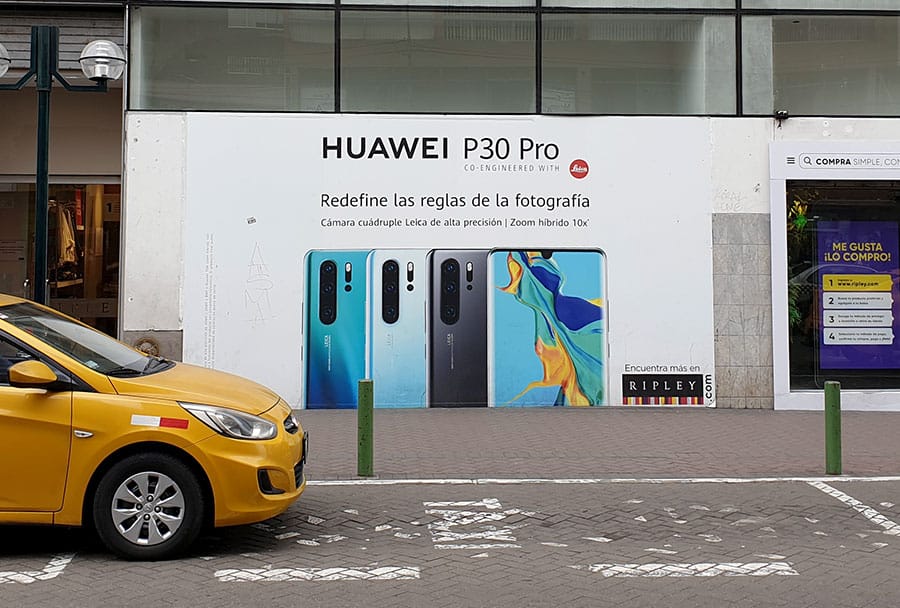
Huawei’s presence in Latin American nations like Panama and Peru (seen here on a Lima side street) is pervasive and dominant. The brand is virtually invisible in the US today. Photo by Mark Lyndersay.
BitDepth#1210 for August 15, 2019
“We’re not going to be doing business with Huawei,” President Donald Trump declared at a press conference on Friday.
As a salvo in the trade disputes between China and the US it was damaging but not decisive.
But for the Chinese manufacturer of devices and broadband infrastructure, it was a devastating broadside that hampers their plans to provide equipment for next generation 5G deployments and shakes confidence in the company’s ability to deliver competitive high-end smartphones.
Huawei is the most visible company in this trade tangle, but it isn’t alone.
Also banned from US commercial consideration are Higon, Sugon, Chengdu Haiguang Integrated Circuit, Chengdu Haiguang Microelectronics Technology and Wuxi Jiangnan Institute of Computing Technology.
In response to the presidential ban, the company issued a formal statement days later.
“The news was not unexpected as it is the continued promulgation of the rules laid out by the National Defense Administration Act (NDAA) of 2019. However, Huawei continues to challenge the constitutionality of the ban in federal court.”
“The NDAA law and its implementing provisions will do nothing to ensure the protection of U.S. telecom networks and systems and rather is [a] trade barrier based on country-of-origin, invoking punitive action without any evidence of wrong doing.”
“Ultimately, it will be rural citizens across the U.S. that will be most negatively impacted as the networks they use for digital connectivity rely on Huawei.”
On the day of President Trump’s slapdown of the company, Huawei had its own announcement, a commitment to a new smartphone operating system, Harmony.
Huawei plans to introduce the new open source OS in China as Hongmeng (part of Chinese mythology, the name references the primordial beginnings) first before rolling out globally.
One key point in a very technical release is how optimistic the company is about the capabilities of its new Ark compiler for Harmony.
A new OS is essentially useless without a strong complement of apps and much of the potential of Harmony will depend on what the real world experience of transforming code from one platform to another turns out to be in practice.
A new OS is essentially useless without a strong complement of apps. The potential of Harmony will depend on the real world experience of transforming code from one platform to another.
And make no mistake, it’s going to need to be really easy as a first step, because building a new OS platform is no joke.
Microsoft failed at it with Windows Mobile, though they had hardware issues that contributed to that debacle.
Samsung hasn’t been able to do much with Tizen and Blackberry’s efforts to modernize its OS collapsed in the face of Android juggernaut.
For Huawei to rebuild even a basic app store that’s capable of replicating current smartphone capabilities, it will have to persuade US companies or third-parties to create Harmony compatible versions of apps ranging from Facebook’s suite to such essentials as Uber, Netflix, YouTube and Snapchat.
Under the terms of the executive order, building the apps and leaving them somewhere for Huawei users to find might not be illegal, but it seems like a lot of work for everyone.
HarmonyOS is meant for all Huawei’s devices and makes its debut on new Honorvision TVs that will be introduced in China next week.
Huawei’s other smartphone problems include hardware as well as software.
For a smartphone to connect to a mobile cellular network, it must use a baseband processor chip. Qualcomm, a US technology company bas 52 percent market share and is notorious for playing hardball with its technology, demanding robust licensing terms before supplying chips for use in devices.
As a pioneer in the mobile phone industry, Qualcomm holds what are described as “standards essential” patents, which are expected to be licensed on fair, reasonable, and nondiscriminatory terms.
The FTC launched an anti-competitive suit against the company in January and Apple, which has had ongoing legal tussles with the company, is believed to be pursuing its own chip designs for baseband connection.
Huawei has strong credibility as a chip designer. The company’s Kirin chip is a strong contender in the smartphone market and it has the capability to design its own baseband chips, but that’s a project that will take time and micro-manufacturing talent that’s still to be developed to appropriate scale in China.
The Kirin chip, designed by Huawei’s HiSilicon Group, is manufactured in Taiwan.


